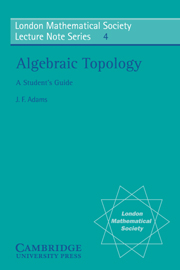Book contents
- Frontmatter
- Contents
- INTRODUCTION
- PAPERS ON ALGEBRAIC TOPOLOGY
- 1 Combinatorial homotopy
- 2 An axiomatic approach to homology theory
- 3 La suite spectrale. 1: Construction générale
- 4 Exact couples in algebraic topology
- 5 The cohomology of classifying spaces of H-spaces
- 6 Cohomologie modulo 2 des complexes d'Eilenberg-MacLane
- 7 On the triad connectivity theorem
- 8 On the Freudenthal theorems
- 9 The suspension triad of a sphere
- 10 On the construction FK
- 11 On Chern characters and the structure of the unitary group
- 12 Espaces fibrés et groupes d'homotopie. I, II
- 13 Generalised homology and cohomology theories
- 14 Relations between ordinary and extraordinary homology
- 15 On axiomatic homology theory
- 16 Characters and cohomology of finite groups
- 17 Extract from thesis
- 18 Relations between cohomology theories
- 19 Vector bundles and homogeneous spaces
- 20 Lectures on K-theory
- 21 Vector fields on spheres
- 22 On the groups J(X). IV
- 23 Summary on complex cobordism
10 - On the construction FK
Published online by Cambridge University Press: 23 May 2010
- Frontmatter
- Contents
- INTRODUCTION
- PAPERS ON ALGEBRAIC TOPOLOGY
- 1 Combinatorial homotopy
- 2 An axiomatic approach to homology theory
- 3 La suite spectrale. 1: Construction générale
- 4 Exact couples in algebraic topology
- 5 The cohomology of classifying spaces of H-spaces
- 6 Cohomologie modulo 2 des complexes d'Eilenberg-MacLane
- 7 On the triad connectivity theorem
- 8 On the Freudenthal theorems
- 9 The suspension triad of a sphere
- 10 On the construction FK
- 11 On Chern characters and the structure of the unitary group
- 12 Espaces fibrés et groupes d'homotopie. I, II
- 13 Generalised homology and cohomology theories
- 14 Relations between ordinary and extraordinary homology
- 15 On axiomatic homology theory
- 16 Characters and cohomology of finite groups
- 17 Extract from thesis
- 18 Relations between cohomology theories
- 19 Vector bundles and homogeneous spaces
- 20 Lectures on K-theory
- 21 Vector fields on spheres
- 22 On the groups J(X). IV
- 23 Summary on complex cobordism
Summary
The next paper is an unpublished one by Milnor, to which many other authors have referred. The work on semi-simplicial loop-spaces has been carried further by Kan; however, Milnor's work remains the standard reference for the generalisation of Hilton's theorem. The prerequisite is a knowledge of semisimplicial complexes; see the remarks in §3 and the book by May. In particular, for the ‘geometrical realization’ appearing in Lemma 1, see May chap. Ill or Milnor, ‘The geometrical realization of a semi-simplicial complex’, Annals of Math. 65 (1957), 357-362.
Introduction
The reduced product construction of loan James assigns to each CW-complex a new CW-complex having the same homotopy type as the loops in the suspension of the original. This paper will describe an analogous construction proceeding from the category of semi-simplicial complexes to the category of group complexes. The properties of this construction FK are studied in §2.
A theorem of Peter Hilton asserts that the space of loops in a union S1…Sr of spheres splits into an infinite direct product of loops spaces of spheres. In §3 the construction of FK is applied to prove a generalization (Theorem 4) of Hilton's theorem in which the spheres may be replaced by the suspensions of arbitrary connected (semi-simplicial) complexes.
The author is indebted to many helpful discussions with John Moore.
The construction
It will be understood that with every semi-simplicial complex there is to be associated a specified base point.
- Type
- Chapter
- Information
- Algebraic TopologyA Student's Guide, pp. 118 - 136Publisher: Cambridge University PressPrint publication year: 1972
- 13
- Cited by

